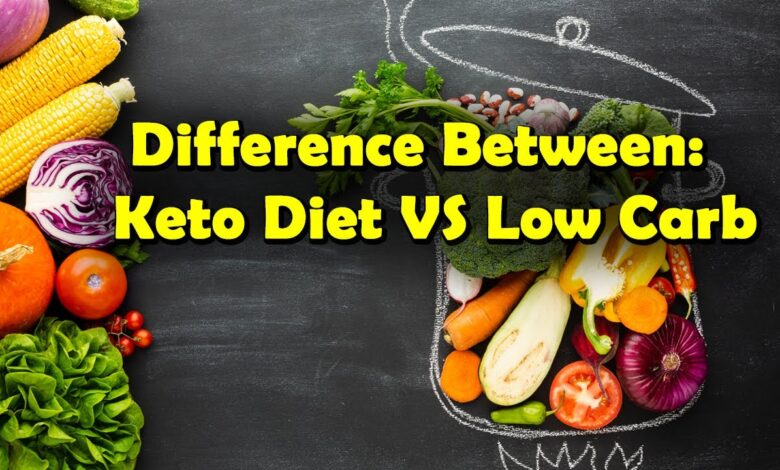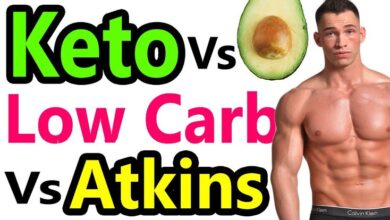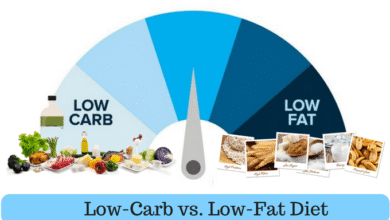
When it comes to shedding extra pounds, few debates are as fierce as Keto vs Low-Fat. Both promise fat loss, improved energy, and better health—but which one actually delivers? For years, nutrition experts, dieters, and fitness enthusiasts have tried to answer this question. Some swear by the high-fat, low-carb keto plan that turns your body into a fat-burning machine, while others prefer the more traditional low-fat diet that reduces calorie intake by limiting fats.
If you’ve ever wondered which is right for you, you’re not alone. Choosing the right diet can make or break your weight loss journey. In this in-depth guide, we’ll break down everything—from how each diet works to their real-world results, benefits, and downsides—so you can make an informed decision that suits your goals and body type.
Read Also Keto vs. Low-Fat Diets: The Ultimate Guide for Lasting Weight Loss Results
Understanding the Science Behind Keto and Low-Fat Diets
Before jumping into the pros and cons, let’s understand what sets these two diets apart at the most fundamental level.
A Keto diet (short for ketogenic) drastically reduces carbohydrate intake—usually under 50 grams per day—and increases fat consumption to about 70–80% of your total calories. The goal? To push your body into a metabolic state called ketosis, where it burns fat for fuel instead of glucose.
A Low-Fat diet, on the other hand, focuses on reducing fat intake to around 20–30% of your total daily calories. This approach promotes weight loss by cutting back on calorie-dense foods, since fat contains more than double the calories of carbs or protein per gram.
Think of Keto as your body’s “fat-burning switch” and Low-Fat as your “calorie-balancing act.” Both aim for the same destination—weight loss—but take very different roads to get there.
1. How the Keto Diet Works for Weight Loss
The Keto diet shifts your metabolism from burning glucose (sugar) to burning stored fat. This process is called ketosis. When your carb intake is extremely low, your liver converts fats into molecules known as ketones, which become your body’s primary energy source.
Here’s what happens step by step:
- You drastically cut carbohydrates.
- Your body depletes stored glycogen.
- The liver starts producing ketones.
- You begin burning fat efficiently for energy.
That’s why keto followers often report rapid weight loss, especially in the first few weeks. According to research published by the National Library of Medicine, people on a ketogenic diet tend to lose more weight initially compared to those on a low-fat diet due to decreased water retention and appetite suppression.
2. How the Low-Fat Diet Promotes Weight Loss
The Low-Fat diet works on a simple principle: reduce calorie intake by limiting fats. Since fats contain 9 calories per gram (compared to 4 in carbs or protein), lowering fat consumption automatically reduces total calorie intake.
This approach focuses on:
- Lean proteins (like chicken breast, fish, or beans)
- Whole grains (like brown rice, oats, and quinoa)
- Vegetables and fruits
Unlike Keto, you can still enjoy your favorite carbs—but moderation is key. Studies from institutions like the Harvard School of Public Health suggest that while low-fat diets may result in slower weight loss initially, they can be easier to sustain long-term for people who enjoy carbohydrates.
3. Macronutrient Breakdown Comparison
| Diet Type | Carbohydrates | Fats | Protein | Primary Fuel Source |
|---|---|---|---|---|
| Keto | 5–10% | 70–80% | 15–25% | Fat (Ketones) |
| Low-Fat | 50–60% | 20–30% | 15–20% | Carbohydrates (Glucose) |
This table clearly shows how differently both diets manipulate your macronutrient balance to achieve weight loss.
4. Short-Term vs. Long-Term Weight Loss
In the short term, Keto often wins the race. People can lose up to twice as much weight in the first few months compared to a low-fat diet. However, when we stretch the timeline beyond a year, the gap tends to close.
The Low-Fat diet, though slower in producing results, may be easier to maintain for those who dislike restricting entire food groups. Sustainability, not speed, often determines long-term success.
5. Energy and Mental Clarity: Which Feels Better?
Keto dieters frequently report higher energy levels and sharper focus after the initial “keto flu” phase. This happens because ketones are a steady energy source for the brain.
However, low-fat dieters who consume healthy carbs (like oats or sweet potatoes) also experience steady energy, especially during workouts. The choice depends on how your body reacts to carb restriction.
6. The Impact on Cholesterol and Heart Health
One of the main criticisms of the keto diet is its high intake of saturated fats. While some studies show that it can increase HDL (good cholesterol), it can also raise LDL (bad cholesterol) in certain individuals.
A low-fat diet, rich in fiber and low in saturated fat, generally promotes better cardiovascular health, reducing risks of stroke and heart disease over time.
For balanced insight, check out reliable sources like American Heart Association for detailed guidelines.
7. Keto vs Low-Fat: Appetite and Cravings
The keto diet has a natural appetite-suppressing effect. Fat and protein are more satiating, meaning you feel full longer.
On the other hand, low-fat diets can sometimes leave you feeling hungrier, especially if they’re carb-heavy. However, adding fiber-rich foods like whole grains and vegetables can help balance hunger levels effectively.
8. Which Diet Supports Muscle Growth Better?
Keto may help preserve muscle mass during fat loss due to higher protein and fat intake. However, athletes and bodybuilders often prefer low-fat diets because carbohydrates fuel strength and endurance.
If your goal is weight loss with muscle definition, consider a modified keto plan with strategic carb intake (known as cyclical keto).
9. Cost and Accessibility
Keto can be more expensive since it relies on premium fats—avocado, nuts, salmon, coconut oil. Meanwhile, low-fat diets are often budget-friendly, relying on affordable staples like rice, beans, and vegetables.
For African and American households, where staple diets differ, cost and availability can heavily influence sustainability.
10. Side Effects and Risks
Keto Diet Risks:
- Initial fatigue (keto flu)
- Digestive issues (constipation)
- Nutrient deficiency (due to carb restriction)
Low-Fat Diet Risks:
- Possible lack of essential fats (omega-3)
- Hunger and energy dips
- Over-reliance on processed carbs
As with any diet, moderation and balance are key.
11. Weight Maintenance: What Happens After You Lose Weight?
Keto can be tricky to maintain long-term due to its restrictions. Once carbs are reintroduced, water weight may return.
Low-fat diets, however, are easier to integrate into everyday eating patterns, making them more sustainable for weight maintenance.
12. How to Decide Which Diet Fits Your Lifestyle
Ask yourself:
- Do I enjoy carbs (bread, rice, fruits)? → Try Low-Fat
- Do I prefer meats, eggs, and dairy? → Consider Keto
- Do I want fast results or long-term flexibility? → Choose accordingly
Your decision should align with your lifestyle, culture, and budget, not just trends.
13. Expert Recommendations and Studies
Nutritionists often recommend combining the best of both worlds—a balanced approach. A moderate low-carb or low-fat diet, emphasizing whole foods and portion control, tends to produce sustainable results.
You can explore studies published on NIH.gov for up-to-date clinical findings.
14. How to Transition Safely Between Diets
Switching from low-fat to keto (or vice versa) requires adjustment:
- Gradually reduce or reintroduce carbs.
- Monitor your energy and digestion.
- Stay hydrated and include multivitamins.
This ensures minimal side effects and better long-term adaptation.
15. Final Verdict: Keto or Low-Fat – What Should You Choose?
Both Keto and Low-Fat diets can help you lose weight effectively. The real difference lies in personal preference, lifestyle, and consistency.
If you crave quick results and enjoy fats, keto might suit you. If you prefer a balanced, sustainable plan that allows carbs, go for low-fat. The best diet isn’t just the one that burns fat—it’s the one you can stick with long enough to change your life.
Conclusion
Deciding between Keto and Low-Fat isn’t about picking the “perfect” diet; it’s about finding what fits your body and lifestyle. Keto offers speed and appetite control, while Low-Fat promotes heart health and sustainability. Ultimately, consistency, portion control, and self-awareness make the biggest difference—not just macros.
FAQs
1. Which diet burns fat faster?
Keto typically burns fat faster due to ketosis, but results may level out over time compared to low-fat diets.
2. Can I combine Keto and Low-Fat principles?
Yes. Many adopt a moderate low-carb, low-fat hybrid, focusing on whole foods, lean proteins, and healthy fats.
3. Is Keto safe for everyone?
Not always. People with liver, kidney, or heart issues should consult a doctor before starting keto.
4. Which diet is better for long-term weight maintenance?
Low-Fat is often easier to maintain, especially for people who enjoy a variety of foods.
5. Do both diets work without exercise?
Diet alone helps, but pairing either plan with physical activity accelerates fat loss and boosts health outcomes.




